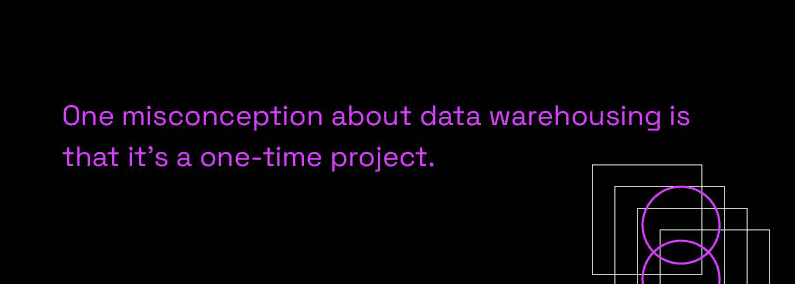
Let’s be real, you can have all the data in the world, but if it’s stuck in silos or scattered across spreadsheets and systems, it’s not doing much for you. If digging for business insights from your scattered data feels like trying to find a matching sock in the laundry basket, a data warehouse can fix that. It’s also an effective way to improve data consistency across departments by eliminating redundant or conflicting datasets.
It centralizes your messy data, keeping it organized for better analysis and reporting. Pair a data warehouse with Power BI consulting, and it becomes a powerful foundation that will transform scattered data into insights that drive decisions. In this post, we’ll define data warehouse and its advantages, and how an experienced consultant can help build a solid data warehouse as the backbone of your data strategy.
What Is a Data Warehouse and Why Should Decision-Makers Care?
To keep it short, we can define a data warehouse as a central place for all of your organization’s data. And we mean all of it—from all your sources and operational systems, giving you a data repository that supports business intelligence tools and analytics with one version of the truth. If you’re focusing on digital transformation or developing a data management strategy, an experienced consultant can build a data warehouse that will support those goals.
There are many advantages of data warehouses, one being that they can play a key role for executives and strategic business outcomes. With consolidated data (both historical and current), a consultant can use analytics to help decision-makers analyze trends to understand key business metrics and identify new opportunities. A data warehouse enables executives with comprehensive, integrated data to make informed, data driven decision making around strategy, operational efficiencies, and resource allocation that can reduce costs and forecast for the future.
A data warehouse gives you a strong foundation for business intelligence (BI) and analytics tools. A BI consultant can integrate the dynamic duo of Power BI and Microsoft Fabric. Fabric includes a lakehouse and warehouse experience designed to unify data and data analytics capabilities workflows, giving Power BI the foundation it needs to turn consolidated data into actionable reports and dashboards. A Power BI consultant can set this up and design visualizations that are tailored to your business goals.
What Are The 5 Key Components and 4 Defining Features of a Data Warehouse?
A data warehouse has five essential components. An experienced consultant will set this up properly to ensure it’s all working seamlessly. Here’s a breakdown:
- Data Sources: Everything from your CRM, ERP, spreadsheets, applications, databases, etc. loads raw data into the warehouse. This unlocks an overall view of your business. These sources can include both structured and unstructured data, which requires specific handling strategies to ensure usability.
- ETL (Extract, Transform, Load): ETL is like the cleanup crew and the moving truck. A consultant will set up data extraction from different sources, transform it into a consistent format, and then load it into the warehouse, so data is accurate, complete, and ready for analysis.
- Data Storage: The heart of the data warehouse—a central place for all current and historical data. A consultant will choose data storage that fits your needs (on-premises, cloud-based, or a hybrid solution) by looking at data volume, data security, and cost. Using the right storage method can significantly reduce data storage costs while maintaining performance.
- Metadata: Metadata is data about your data in the warehouse. Wait, what? It explains the content, how it’s structured, and how it should be used. It’s super important for data governance and keeping data management in check. Consultants often use metadata to support data quality initiatives and improve discoverability.
- Data Access/Presentation: Here’s the powerful part. Data access tools like Power BI allow users to tap into the warehouse. A consultant will guide your team on how to access data using queries, use reporting and analytics tools, and visualize data in the data warehouse.

You may be wondering what makes a data warehouse different from traditional data management systems. There are four defining features (or characteristics) that make a data warehouse an incredibly reliable tool for strategic decision-making and more in-depth analysis. A consultant ensures this is set up the right way.
- Subject-Oriented – Unlike traditional databases focused on day-to-day operations, data warehouses are organized to key business domains — like sales, finance, or inventory — so you can zoom out and analyze big-picture performance.
- Integrated – Data is unified from different systems, cleaned, and standardized, giving teams a consistent, trusted view of the business.
- Time-Variant – Data warehouses store historical data, keeping snapshots that cover years (yes, years) of activity. Data entry is timestamped so decision-makers can compare data and performance, track changes, and analyze trends over time for more strategic and trustworthy decisions. Teams can collaborate to understand what key metrics are being hit (or not) and the long-term impact of strategies.
- Non-Volatile – Once data is loaded, it typically doesn’t get modified or deleted. Even if source data changes, what’s in the data warehouse stays the same. Historical records stay consistent for reliable future analysis, audit trails, and regulatory compliance. No need to stress about data loss or corruption. Everyone’s working with an unchanging historical record for better collaboration, less confusion, and better decisions. Plus, data reliability is in check since this feature prevents unintentional or malicious changes to historical information.
One misconception about data warehousing is that it’s a one-time project. But they actually require some ongoing maintenance and adaptation. Here’s where a consultant makes a huge difference. They’ll be sure you’re set up to handle this, as well as tackle any potential challenges of a data warehouse, like data integration complexities, scalability, and security concerns.
What Are the Top Benefits of a Data Warehouse?
Let’s face it, sometimes it may feel like you need a search party to find valuable insights in your data. If you find you’re spending too much time hunting through spreadsheets looking for answers, a data warehouse can help. The benefits gained will transform how you use your data. And the right consultant will help set you up for success.
- Better, Faster Analytics: When data is centralized, consistent, and well-governed, you’re empowered with much better analytics. Data warehouses pull together data, clean it, and transform it into a unified format. That means data is accurate and reliable, giving you insights you can trust (faster and with way less manual effort). This efficiency can lead to significant cost savings for your business operations.
- Speedier Reporting: Rather than pulling data from a bunch of disconnected sources or manually prepping and cleaning data, data warehouses streamline the process (using ETL)—your data is stored, prepped, and ready for analysis. Consultants can then use tools like Microsoft Fabric and Power BI to accelerate reporting and deliver insights in less time than it takes for your eyes to glaze over from spreadsheet overload.
- Stronger Data Governance and Security: With everything in one place, it’s much easier to set up data governance policies that keep your data secure, compliant, and responsibly used. Data warehouses provide a secure environment to store sensitive data. A consultant can build this environment and configure robust data security measures; you’ll have peace of mind knowing your data is protected from unauthorized access.
- Scalable for Growth: When your business grows, so does your data. A scalable data warehouse grows with you. A well-designed data warehouse (built with expert guidance) can support more users, more data, and more complex queries, without affecting performance. Even explosive data growth is handled with ease (no migraines required). Effective use of compute and storage resources ensures the system remains responsive.
- A Foundation for Advanced Analytics and AI: Data warehouses power advanced analytics by centralizing data from across your sources and your entire organization, and by keeping historical data safe and sound. This enables AI and predictive models to detect patterns, forecast trends, and generate accurate predictions. They support automation and, when paired with streaming architectures, can even handle near real-time analytics, powering faster, more responsive decision-making. Data-driven decisions happen faster than you can say ‘that’s a great idea’. By centralizing clean, historical data, data warehouses provide the fuel that AI and predictive models need to detect patterns and forecast trends.
- A Single Source of Truth: When you combine data warehouses and modern analytics tools like Power BI, you’ve got a powerful team for business intelligence. How so? Centralized data means no more data silos. Everyone’s working with a single source of truth, supporting cross-platform business processes. Customer data can be leveraged more effectively when everyone accesses the same trusted source.
Challenges, Disadvantages, and How to Get Data Warehousing Right
Getting data warehousing right takes experience and knowing how to sidestep challenges. When you partner with consulting services, they bring the expertise and experience to help you take advantage of the benefits and avoid any disadvantages of a data warehouse.
The cost of building a data warehouse can be an investment challenge for some businesses, especially small to mid-sized companies. A consultant can explore cost-saving strategies that make sense for you, like cloud-based vs. on-premises solutions. They can also ensure data storage and queries are optimized for better data warehouse performance, which can help reduce data storage costs.
Data complexity can lead to integration headaches when you’re integrating data from various systems with different data formats and structures. Integrating real-time data with batch data can add to the complexity. A consultant can set up integration in a phased approach to help manage complexity and use robust ETL/ELT tools that help automate integration and handle diverse data formats. Tools like an operational data store may also be used to manage real-time data access needs between systems and the main warehouse.
The future is bright for data warehousing as more and more businesses gravitate towards cloud-based solutions. In fact, the market is expected to grow to a jaw-dropping $51.18 billion by 2028. Don’t look at data warehousing as just a storage locker, but as a strategic enablement tool for your data. Your data strategy will be supported in the future with data warehousing trends like AI and machine learning automation, more cloud-based data warehouses (think Azure Synapse), data mesh, and adaptive analytics.
With a modern consulting approach, we help tame complexity and find the most cost-effective, cloud-based solutions for your unique needs. We’ll work closely with you to understand what’s working, what’s not, and where opportunities lie, then design a solution that supports your business goals. From optimizing data warehouse performance to setting up automated alerts that flag potential issues and cost overruns, to making sure your pricing model fits your budget, we’ll help you maximize your ROI.
With the right data warehouse strategy in place, your data will work for you in ways you never even dreamed of. P3 Adaptive can help you optimize that strategy by exploring options that make sense for your goals and help you find insights in your data that will transform your business (and keep you way ahead of the competition). Our consultants are data experts who love what they do. Let’s explore what they can do for you.
Get in touch with a P3 team member